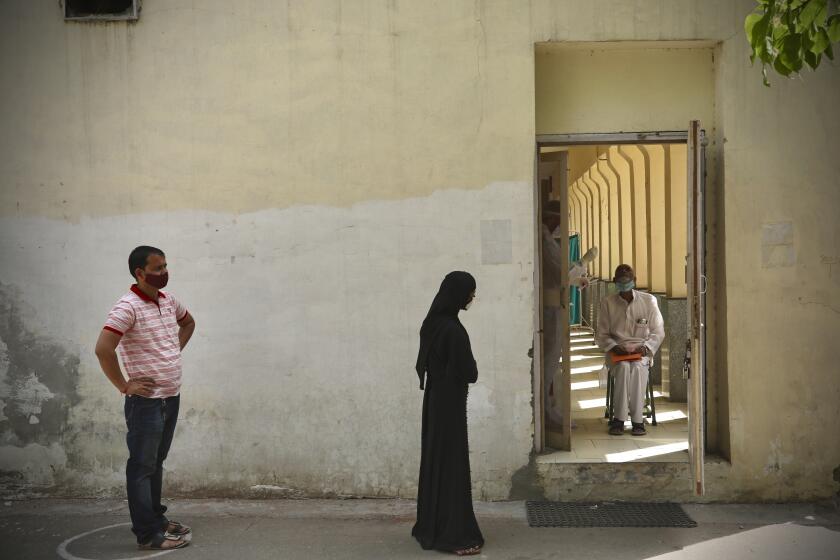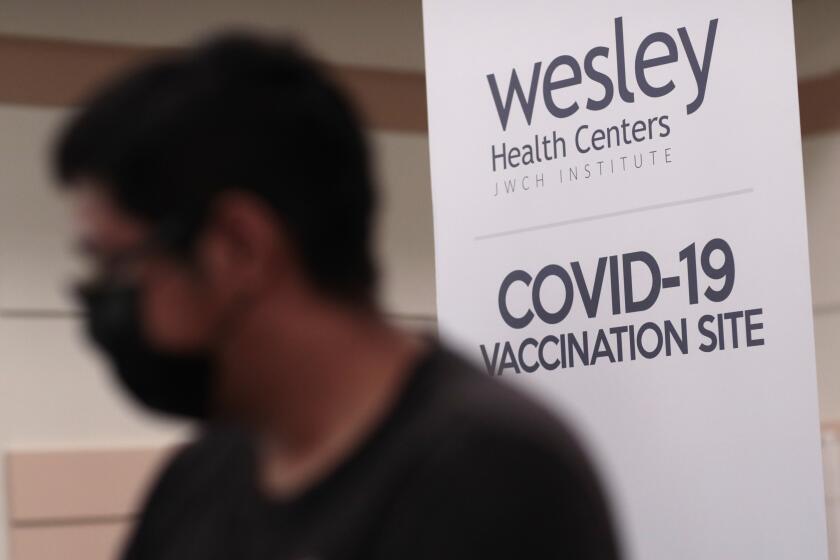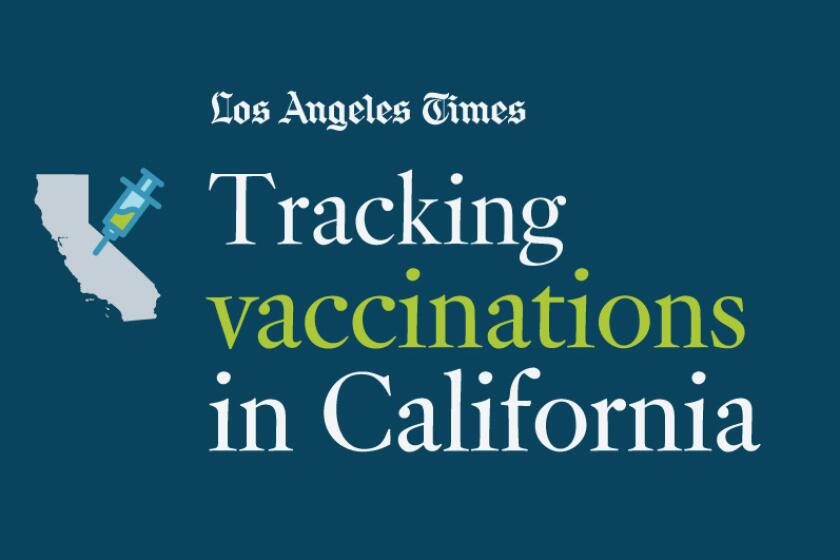‘Double mutant’ coronavirus variant is found in California
SAN FRANCISCO — A possibly worrisome variant of the coronavirus first identified in India — so new that it has no official name — has been found in California by scientists at Stanford University.
Nicknamed the “double mutant” variant by the BBC and others, the variant is sparking concern among some scientists because it contains not just one, but two worrisome mutations in its genetic composition that have been identified among other variants of concern being tracked by the U.S. Centers for Disease Control and Prevention.
“We don’t know how those two mutations behave when they’re paired together,” Dr. Benjamin Pinsky, director of the Clinical Virology Laboratory at Stanford, said in an interview Monday.
The existence of the newly discovered variant was first disclosed by India’s government on March 24, Pinsky said, after a surge of coronavirus cases was detected in the nation’s second-most populous state, Maharashtra, whose largest city is Mumbai. The new variant is responsible for roughly 15% to 20% of new coronavirus cases there.
A day later, on March 25, the Stanford lab identified the same variant in a coronavirus sample taken from a patient in the San Francisco Bay Area.
“On the 25th, we actually got our sequence back and found that, ‘Wow, this is actually the same variant that they’re talking about,’” Pinsky said. “So this rapid spread across the globe is pretty impressive, and also a bit concerning.”
As California reopens further, wariness remains more than a year since the COVID-19 pandemic began. Residents wonder: Is it too soon to return to normality?
Why this new variant may be worrisome
The Stanford lab identified one confirmed case of the new variant and seven presumptive cases among samples from patients in the Bay Area, Pinsky said.
None of the other variants being monitored by federal officials have the same combination of these two mutations, known as L452R and E484Q, the latter of which is closely related to a more well-known mutation known as E484K.
The L452R mutation became well known in California as one found in the California variant (B.1.427/B.1.429), resulting in a strain that is believed to make the virus more infectious and might cause reduced immunity in people who have been vaccinated.
The E484Q mutation is closely related to the E484K mutation, which has been found in variants first identified in South Africa (B.1.351); Brazil (P.1 and P.2) and New York (B.1.526). The E484K mutation is also concerning because it might give the virus the ability to partly evade the immune system’s protective response among inoculated people or those who have survived a conventional COVID-19 illness.
“What we don’t know is how those [two mutations] will behave when they’re put in the same virus,” Pinsky said. “There’s a reasonable amount of information about those [two mutations] individually. But will it be worse if they’re together? We don’t really know how they’re going to interact.”
The Stanford lab routinely performs genetic analysis for coronavirus specimens among COVID-19 patients in the Bay Area. They screen for three worrisome mutations: L452R, E484K, and N501Y. The N501Y mutation — thought to increase the transmissibility of the coronavirus — is found in the U.K. variant (B.1.1.7), as well as the South African variant and one of the Brazilian variants (P.1).
The Stanford lab was able to detect the new variant’s E484Q mutation, even though the lab is designed to detect only the closely related E484K mutation. “So it’s kind of fortuitous that we were able to identify this,” Pinsky said.
India’s daily confirmed coronavirus cases have recorded their biggest single-day spike since the COVID-19 pandemic began.
Variant highlights importance of vaccinations
The emergence of the new variant underscores how important it will be to quickly vaccinate as many people as possible. The best known New York variant, B.1.526, is believed to have emerged in the Washington Heights neighborhood in Manhattan and then quickly spread through the city, Dr. Anthony Fauci, the nation’s top infectious diseases expert, said at a briefing last month.
One way variants can emerge is through the infection of a single person who has a compromised immune system, Dr. Rochelle Walensky, the director of the Centers for Disease Control and Prevention, said in March.
A coronavirus infection in a person with a weak immune system “could be the breeding ground of the emergence of variants for the simple reason that if you don’t clear the virus rapidly, you’re going to have immunological selection within a given individual,” meaning the virus could evolve in that person to become even more robust.
“That was probably how all this started with [New York’s B.1.526 variant],” Fauci said on March 1.
The only way to curb the creation of new variants is to slow the transmission of the virus.
A potential nightmare scenario could result from the spread of variants like the kind that has struck Brazil. The city of Manaus was one of the hardest hit in the world with a conventional strain of the coronavirus, and it now appears that there’s a lot of substantial reinfection with the new Brazilian variant, Dr. Stefano Bertozzi, professor of health policy and dean emeritus of the UC Berkeley School of Public Health, said at a UC San Francisco forum last month.
However, immunity produced by vaccines is believed to be better than immunity produced by surviving COVID-19.
And while some variants are believed to result in the slight reduction of the effectiveness of some vaccines, some experts say that reduction equates to only mild to moderate illness.
Vaccines that are now available and under development have essentially been 100% protective against death — even in places where the variants have circulated widely.
For instance, COVID-19 vaccines manufactured by Johnson & Johnson, Novavax and AstraZeneca were studied in South Africa, and “all showed reduced efficacy compared to studies carried out in other parts of the world where [the South African B.1.351 variant] wasn’t present,” Pinsky said. “However, it’s important to note that all the vaccines are very effective at preventing severe disease and death. Basically, all the vaccines are 100% effective at that so far.”
“Vaccines can actually address these variants effectively,” Andy Slavitt, a senior advisor for the White House’s COVID-19 response team, said Monday.
California continues to buck the COVID-19 spring surge. But are there causes for concern?
‘We’re concerned’
When asked about the new variant, Los Angeles County Public Health Director Barbara Ferrer said, “We, like everyone else, are concerned.”
“The tool we have right now for everybody is to prevent as much transmission as possible because that means the variants don’t circulate either,” Ferrer said at a briefing Monday. “The more we have transmission, the more it is [that] variants take hold.”
The U.K. variant is the most prevalent detected in the United States. More than 15,000 cases have been reported in all 50 states, the District of Columbia and Puerto Rico. By contrast, the South African variant has been detected in more than 300 cases, and the Brazilian P.1 variant has been identified in more than 200 cases — and neither of those variants have been detected in every state.
In California, the two most dominant variants are the California and U.K. variants. The California Department of Public Health has recorded more than 9,000 cases of the California variant and 851 of the U.K. variant. There have been 35 cases of the Brazilian P.1 variant, 33 cases of the New York B.1.526 variant, 22 cases of the Brazilian P.2 variant and 10 cases of the South African variant.
In L.A. County, the South African, U.K. and Brazilian variants have been detected, but none of them are dominating the area, Ferrer said.
“We’d like to keep it that way. So, let’s all do our part: Let’s get vaccinated when it’s our turn,” she said
The emergence of the new variant comes as other pandemic indicators in California are better than in most of the nation.
Experts say about most Americans will need to be vaccinated to bring the coronavirus pandemic under control. Track California’s progress toward that goal.
“California now has the lowest positivity rate in the country,” Gov. Gavin Newsom tweeted Monday. Among all states, California also has the third-lowest coronavirus case rate per capita over the past week in the country, according to the CDC, with 46 new coronavirus cases per 100,000 residents over the past seven days. Only Oklahoma and Arkansas have reported lower rates.
Michigan, meanwhile, has the worst case rate in the nation, with 452.5 cases per 100,000 residents over the past week, followed by New Jersey and New York.
Still, officials have voiced concerns that the situation in California could worsen if people suddenly decide to stop wearing masks and gather in crowds. Only one-third of Californians are at least partially vaccinated.
“Our reality, with more variants and increases in cases across the country and much of the world, and lots more intermingling here in L.A. County, is such that we’re going to need to continue following public health safety measures until more people are vaccinated if we want to hold on to our gains,” Ferrer said.
Lin reported from San Francisco, Money from Los Angeles.
More to Read
Sign up for Essential California
The most important California stories and recommendations in your inbox every morning.
You may occasionally receive promotional content from the Los Angeles Times.
















